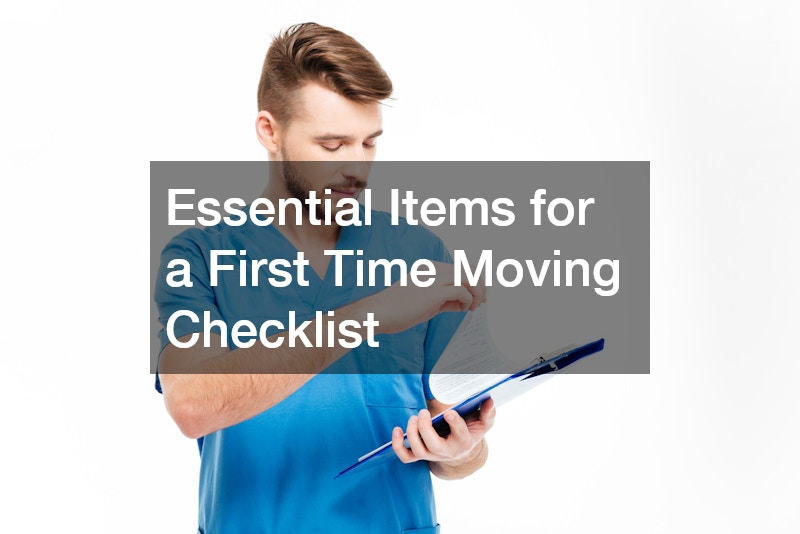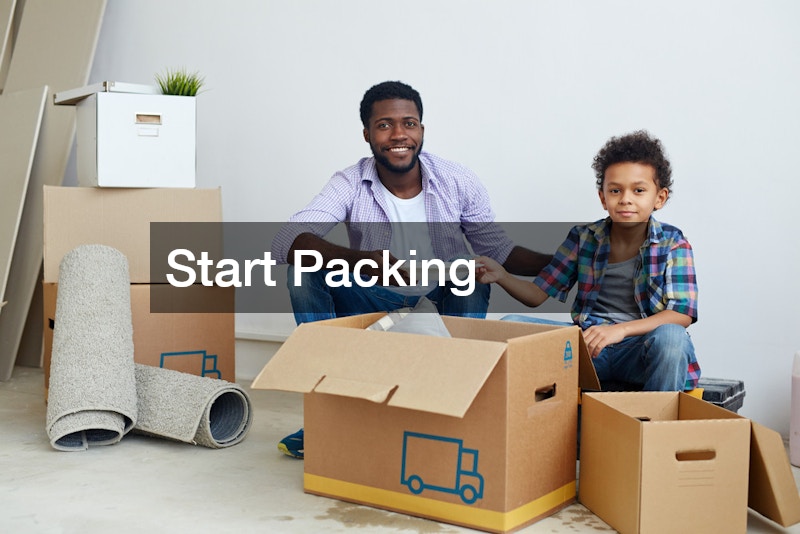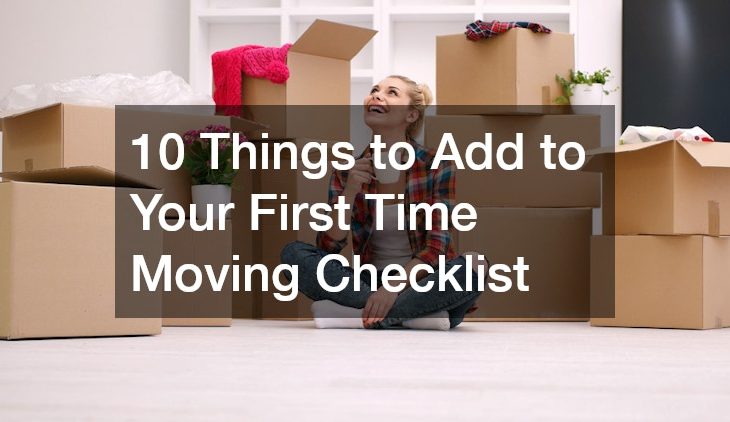10 Things to Add to Your First Time Moving Checklist

Moving to a new home for the first time can be an exhilarating yet daunting experience. Whether you are moving out of your parents’ house, relocating for a job, or simply seeking a fresh start, the process involves many tasks that require careful planning and execution. Utilizing a detailed first time moving checklist can significantly ease the transition, ensuring that you have all essentials covered. This guide aims to provide comprehensive advice on everything from budgeting and packing to setting up utilities and finding key contacts in your new location. We will delve into practical tips on how to handle your belongings, choose the right moving services, and make your new home truly your own. By the end of this article, you’ll be equipped with the knowledge and confidence to tackle your move with minimal stress and maximum efficiency.
Essential Items for a First Time Moving Checklist

Compiling a first time moving checklist is a critical first step in ensuring that nothing important is overlooked during your move. Start by making a list of essential items you’ll need at your new place, such as toiletries, kitchenware, and bedding. Don’t forget cleaning supplies and tools like a screwdriver and hammer, which can be invaluable for setting up your new home.
In addition to packing supplies, consider what documents and records you may need to keep handy. This includes identification, leasing agreements, any applicable insurance documents, and healthcare records—especially for those with specific needs like childrens health care. Your checklist should include a notes section to jot down items that need attention as moving day approaches.
Keeping a digital version of your checklist can also be very useful. With a digital checklist, you can easily update and share it with family members or roommates involved in the move. Apps and online platforms can help you track what has been packed and what still needs to be done, offering real-time updates on your moving progress.
Budget for Your First Move
One of the most important items on your first time moving checklist is your budget. Budgeting for your first move is just as crucial as packing itself. Begin by sketching out a financial plan that covers your primary costs, including moving services and rental deposits. Determine whether you will need additional storage containers to keep your belongings safe during and after the move.
Calculate other related expenses such as transportation, utility deposits, and any new furniture or home essentials you’ll need after moving in. Don’t forget to include a buffer for unexpected expenses like residential roofing services or air conditioning repairs that may arise after settling in. By having a detailed budget, you can manage your funds wisely and avoid financial stress.
Moving does not have to break the bank. Research affordable home and auto insurance options to safeguard your valuables and reduce financial burdens. Comparing quotes from several companies can lead to better deals that align with your budget and necessary coverage.
Start Packing

The packing process can quickly become overwhelming without a strategic plan. Prioritizing a packing timeline on your first time moving checklist will help pace the process and reduce stress. Establish a timeline that accounts for packing non-essential items first, working your way toward daily necessities as the move-out date gets closer.
Utilizing a room-by-room strategy can make the process more manageable. Start with rooms that hold less frequently used items, such as the guest room or dining area, and gradually move toward essential spaces like bedrooms and bathrooms. This methodical approach can help you maintain order and efficiency.
Take this opportunity to declutter and donate or sell belongings you no longer need. Decluttering not only reduces the number of items to pack but also gives you a fresh start in a new space. Remember, fewer items mean more saved space and money on moving costs.
On moving day, keep a small bag or box with essentials you’ll need immediately, such as a phone charger, toiletries, and a change of clothes. This “first-day kit” can prevent you from rummaging through boxes right after a long day of moving. If possible, schedule your move on a weekday, as weekends can mean higher demand and potentially higher prices for movers. Be sure to confirm your moving company’s arrival time and have a clear plan for parking and entry at your new location.
Before leaving your old place, conduct a final walkthrough to ensure all belongings are packed and that you haven’t left anything behind. Make sure utilities are turned off, and double-check for items in cabinets, closets, and drawers. These extra steps can make a difference in your moving experience, helping you stay organized, minimize stress, and transition smoothly into your new home.
Steps to Safely Move Valuables
Moving valuables requires special attention to ensure they reach your new home intact. Begin by documenting each item. Making an inventory for your first time moving checklist can provide peace of mind. This can also aid in assessing insurance needs to cover unforeseen damages or loss.
Explore different insurance options that adequately cover your valuable items during the move. Be aware that standard moving services may not offer full coverage for high-value items, so separate insurance policies are a wise consideration. Always read the fine print to understand what’s covered and under what conditions.
Special packing methods can greatly reduce the risk of damage. Use ample padding and consider using storage containers designed for fragile items. Double boxing and labeling boxes containing valuables as “fragile” can further emphasize the need for careful handling during transit.
Choose a Reliable Moving Company

Selecting the right moving company can spell the difference between a smooth transition and a logistical nightmare. Start by researching moving services and comparing reviews, credentials, and rates. Add your selected company to your first time moving checklist to ensure communication is clear and expectations are met.
Verify that the moving services you consider are registered and insured, offering solid protection against potential mishaps. Transparency in pricing and clear communication regarding services included in the cost are also key indicators of a reliable mover. Do not hesitate to ask questions and seek clarification on any concerns you might have.
Personal recommendations can be invaluable, especially if you are moving to a new area. Ask friends or family for references to trustworthy movers they have previously worked with. Gathering firsthand accounts of others’ experiences can guide your decision-making process.
Set Up Utilities in Your New Home
Setting up utilities in your new home should be high on your first time moving checklist. Early communication with utility providers can help avoid delays, ensuring that electricity, water, heating, and internet services are operational when you arrive.
Inquire about any deposits required for new accounts, scheduling the connection, or transfer of services at least a week in advance. Address specific requirements such as heating repair or air conditioning setups that might be vital to your comfort and convenience upon moving in.
Sometimes, previous tenants may not have maintained utilities efficiently, resulting in incomplete repairs or issues. Conduct a thorough inspection for potential repairs, such as window repair or faulty installations, so you can address them promptly and enjoy a seamless transition.
Address Changes and Notifications
Updating your address with the necessary parties ensures smooth correspondence post-move. Begin by notifying the postal service of your new address, a critical step on your first time moving checklist to prevent mail from being lost or delivered to the wrong location.
Inform financial institutions, such as banks and credit card companies, about your new address. This prevents billing discrepancies and ensures timely delivery of any important notices or cards. Additionally, update your information with subscription services, pharmacies, and healthcare providers, including any child or pet health clinic you may visit.
For a seamless move, consider writing down a list of all parties that need your new address. Keeping track of adjustments prevents overlooking any parties that might lead to difficulties later on. Digital reminders and notifications can also be handy in keeping you organized during this transition.
Additionally, consider checking the weather forecast for your moving day to plan accordingly. Rain, snow, or extreme heat can affect timing and logistics, so prepare covers or tarps if needed to protect your belongings. Also, remember to update your address on your driver’s license and voter registration, as this is often required by law. Finally, make sure to inspect your new home for any damages before settling in; documenting any issues can help you avoid disputes with your landlord or ensure repairs if you’ve purchased the property.
Make Your New Home Your Own

Making your new home feel like your own is a rewarding part of the moving process and can be the most fun task on your first-time moving checklist. Personalize each room by integrating elements that reflect your personality, such as art pieces, textiles, and family photos. Bringing favorite items from your previous space can also help instill feelings of comfort and familiarity.
In addition to interior design, consider starting a vegetable gardening project in any available outdoor space. It’s a productive and engaging way to make the surroundings of your new home inviting while also reaping the benefits of homegrown produce. Gardening can serve as a therapeutic activity amidst the hustle and bustle of settling in.
Whether through interior adjustments or outdoor enhancements, transform your new environment into a place where you feel genuinely at home. Bridging the old with the new by combining familiar favorites with exciting ventures like vegetable gardening can accelerate your settling-in process.
Contacts to Find in Your New Location
Moving to a new area often entails establishing new contacts essential for your well-being and daily operations. Finding reliable new healthcare providers for your family, including specialized childrens health care and pet health clinic options, is crucial.
Review options for affordable home and auto insurance that protect you against unforeseen incidents. New neighborhoods may also lead to different risk assessments and thus affect your insurance needs. Ensuring comprehensive coverage early on can account for potential local challenges, so add this towards the top of your first time moving checklist.
Community familiarization enhances your settlement experience. Participating in neighborhood events and introducing yourself to new neighbors will instill a sense of belonging. Building local connections can make the transition easier and provide invaluable resources and recommendations for reliable services, from healthcare to home maintenance.
Prepare for the Unexpected
Even with meticulous planning, unexpected challenges can arise during or after a move. Having a plan to handle unforeseen maintenance like residential roofing services or window repair can prevent these issues from becoming larger headaches.
Ensure that you have essential contacts, like those for air conditioning repairs or heating repair professionals, should emergencies occur. This foresight ensures immediate attention to any urgent needs that can disrupt your living conditions.
Maintain a list of all key services you might need to engage quickly and efficiently. By adding this to your first time moving checklist, you are proactively securing peace of mind, knowing you can rely on a network of skilled professionals to restore comfort and functionality in your new home.
Embarking on your first move is undoubtedly a major life event, filled with both anticipation and challenges. With a well-thought-out first time moving checklist, you can manage each aspect of this transition effectively. From budgeting to setting up utilities, remember to stay organized and patient as you prepare. This guide has aimed to equip you with insights into moving processes by choosing reliable moving services. Also, it helps you set roots in your new community through contacts and familiarization activities. Support your family’s health and safety by sourcing essential services like childrens health care, pet clinics, and affordable insurance options early. Remember, the goal is to make your new place feel like home. This is where you can plant new traditions, perhaps quite literally, through vegetable gardening. By preparing for potential hiccups like air conditioning repairs or window fixes and by embracing your new surroundings, the moving process can be a rewarding and less daunting experience. With this checklist in hand, you’re ready to embark on this new chapter with confidence and excitement.
